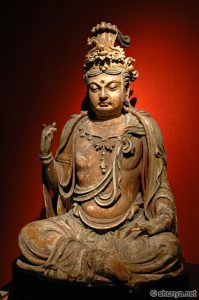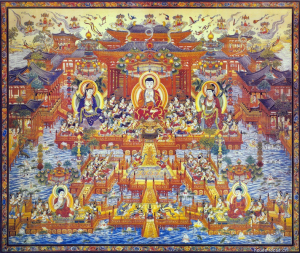
Bodhisattva
The Prajñāpāramitā and Mahayana
The Prajñāpāramitā texts demand too much attention to deny them some form of recognition on this site. I state it now that they are NOT Theravadin texts. They were written in Sanskrit at a later date than the Pali Cannon. I include them though because of the immense effect they have had on Buddhist thought over the centuries. As I believe it, the entire Mahayana movement is based on them, that includes Tibetan Buddhism, one of the most well known traditions due to the influence of the Dalai Lama and the exodus from Tibet caused by the Chinese.
The Mahayana tradition started centuries ago around the beginning of the common era, i.e. 100 to 200 BC. The development seemed to be gradual, according to scholars. Theravada Buddhism emerged after the great schism about 100 years after the death of the Buddha, and it is believed to have occurred due to disputes regarding the Vinaya Pitaka, or the rules regarding the Sangha and the constituent monks.
Theravada vs Mahayana

Mahayana PureLand
Two main factions arose from the Great Schism and, after some time, Theravada Buddhism and Mahayana Buddhism became the dominant streams. Theravadins concentrate on the Pali Cannon as their source of scripture. Mahayana Buddhists have their own list of Suttas that they believe to be scripture. There are, obviously, a whole host of other reasons for the divergence but I could fill an entire blog just going through them. Suffice to say, they have their differences regarding practice and belief. The Theravadins concentrate on enlightenment and Nibbana, the Mahayana concentrate on becoming a Bodhisattva, a being who forgoes Nibbana and returns to this world for the sake of others.
Which Texts to Include
So which texts do I include on this site? The list is somewhat limited due to copyright but I do have a couple of fundamental texts I believe to be either copyright free or at least under a Creative Commons license.
The Heart Sutra
PDF Download
Shorter Prajnaparamita Hṛdaya Sutra
PDF Download
Longer Prajnaparamita Hṛdaya Sutra
Both the above Suttas are known as the ‘Heart Sutta’, or ‘Heart Sutra’ in Sanskrit. These are both core teachings within the Mahayana school of thought. They are both short and to the point. The teachings contained are considered revolutionary in their content, and if you study them closely you will realise why. They state that ‘nothing’ exists, even the Dhamma, so there is no path to follow, and this thought can throw even the most dedicated monk into turmoil. How can the Dhamma not exist if the Buddha spent 45 years explaining it? Yet if you spend time with them, which I have done in the past, the Suttas make sense, and are believable. So do not dismiss them because they are not from the Pali Cannon. Much knowledge and insight can be gained by meditating on them.
The Lotus Sutra
Produced by and disseminated by BDKAmerica under the guise of the dBET program.
To quote their own website:
Publication Programs. The main emphasis of BDK’s work in America includes supporting the BDK English Tripitaka Series project. The full catalog of available publications can be seen here. Another major project is the distribution of The Teaching of Buddha to hotels, prison inmates, schools and other public facilities throughout the nation. The full catalog of our more than 50 editions of The Teaching of Buddha can be found here. BDK provides translations in most of the major languages of the world.
The Lotus Sutra is incredibly important to many East Asian Buddhists and is considered the last and final word of the Buddha, sufficient for salvation.
I provide this dBET Creative Commons edition here for your perusal.
PDF Download
The Lotus Sutra
The Diamond Sutra
I guess one of the most important Mahayana Sutras to include is the Diamond Sutra. This particular Sutra is held in high esteem by the Zen Buddhists as, to quote my source of the text:
The great Sixth Patriarch of Zen, Huineng, is said to have achieved enlightenment after hearing a single line of this sutra. This may explain why Zen Buddhists in particular are attracted to it.
So, without further ado, I present a page containing the Diamond Sutra itself, and a PDF download of the same.
I trust this diversion into the land of Mahayana is not too distracting, but of interest. If those who follow the Mahayana path find benefit and wisdom, then my job is done. At some point in the near future I will construct a proper page for all the Mahayana documents and present them properly, in a manner they deserve.
May all beings find peace.
